Effect of Fermentation Time on Antioxidant and Anti-Ageing Properties of Green Coffee Kombucha Ferments
Abstract
1. Introduction
2. Results and Discussion
2.1. Determination of Bioactive Compounds
2.2. 1,1-diphenyl-2-picrylhydrazyl (DPPH) Radical Scavenging Assay
2.3. Detection of Intracellular Levels of Reactive Oxygen Species (ROS)
2.4. Determination of Superoxide Dismutase (SOD) Activity
2.5. Cell Viability Assay
2.6. Assessment of Matrix Metallopeptidases Inhibition
2.7. Transepidermal Water Loss (TEWL) and Skin Moisture
2.8. Determination of Sun Protection Factor (In Vitro)
3. Materials and Methods
3.1. Plant Material and Fermentation Procedure
3.2. Determination of Biologically Active Compounds
3.2.1. The Determination of the Total Phenolic Content (TPC)
3.2.2. The Determination of the Total Flavonoids Content (TFC)
3.2.3. Determination of Bioactive Compounds by HPLC–UV-ESI–MS
- c is the concentration of interesting isomer in g/L,
- RF is the response factor of the 5-CQA standard in gmAV−1 min−1,
- ∈1 is the molar extinction coefficient of 5-CQA in M−1 cm−1,
- ∈2 is the molar extinction coefficient of interesting analogue or positional isomer in M−1 cm−1,
- MR1 is a molecular weight of 5-CQA in g/mol,
- MR2 is a relative molecular weight of interesting isomer in g/mol,
- A is an area of peak of the interesting isomer in mAV min.
3.3. Assessment of Antioxidant Activity
3.3.1. DPPH Radical Scavenging Assay
- Abs control is the absorbance of the control sample (containing DPPH and water),
- Abs sample is the absorbance of the test sample (containing DPPH and test sample).
3.3.2. Detection of Intracellular Levels of Reactive Oxygen Species (ROS)
3.3.3. Determination of Superoxide Dismutase (SOD) Activity
3.4. Cell Culture
3.5. Cell Viability Assay
3.5.1. Neutral Red Uptake Assay
3.5.2. Alamar Blue Assay
3.5.3. Lactate Dehydrogenase (LDH) Cytotoxicity Assay
3.6. Assessment of Matrix Metallopeptidases Inhibition
3.6.1. Determination of Anti-Collagenase Activity
3.6.2. Determination of Anti-Elastase Activity
3.7. Transepidermal Water Loss (TEWL) and Skin Hydration Measurements
3.8. Determination of Sun Protection Factor (In Vitro)
- EE (λ)—erythemal effect spectrum,
- I (λ)—solar intensity spectrum,
- Abs (λ)—absorbance of sunscreen product,
- CF—correction factor (= 10),
- E (λ) × I(λ)—values determined by Sayre were used [62].
3.9. Statistical Analysis
4. Conclusions
Author Contributions
Funding
Conflicts of Interest
References
- Thapa, N.; Tamang, J. Functionality and Therapeutic Values of Fermented Foods. Health Benefits Fermented Foods Beverages 2015, 111–168. [Google Scholar] [CrossRef]
- Sivamaruthi, B.S.; Chaiyasut, C.; Kesika, P. Cosmeceutical importance of fermented plant extracts: A short review. Int. J. Appl. Pharm. 2018, 10, 31–34. [Google Scholar] [CrossRef]
- Lee, H.-S.; Kim, M.-R.; Park, Y.; Park, H.J.; Chang, U.J.; Kim, S.Y.; Suh, H.J. Fermenting red ginseng enhances its safety and efficacy as a novel skin care anti-aging ingredient: In vitro and animal study. J. Med. Food 2012, 15, 1015–1023. [Google Scholar] [CrossRef] [PubMed]
- Hsu, M.-F.; Chiang, B.-H. Stimulating effects of Bacillus subtilis natto-fermented Radix astragali on hyaluronic acid production in human skin cells. J. Ethnopharmacol. 2009, 125, 474–481. [Google Scholar] [CrossRef] [PubMed]
- Lee, S.; Kim, J.-E.; Suk, S.; Kwon, O.W.; Park, G.; Lim, T.-G.; Seo, S.G.; Kim, J.R.; Kim, D.E.; Lee, M.; et al. A fermented barley and soybean formula enhances skin hydration. J. Clin. Biochem. Nutr. 2015, 57, 156–163. [Google Scholar] [CrossRef]
- Cha, J.; Yang, H.; Moon, H.; Cho, Y. Inhibitory effect and mechanism on melanogenesis from the fermented herbal composition for medical or food uses. Food Res. Int. 2012, 45, 225–231. [Google Scholar] [CrossRef]
- Leal, J.M.; Suárez, L.V.; Jayabalan, R.; Oros, J.H.; Escalante-Aburto, A. A review on health benefits of kombucha nutritional compounds and metabolites. CyTA J. Food 2018, 16, 390–399. [Google Scholar] [CrossRef]
- May, A.; Narayanan, S.; Alcock, J.; Varsani, A.; Maley, C.; Aktipis, A. Kombucha: A novel model system for cooperation and conflict in a complex multi-species microbial ecosystem. PeerJ 2019, 7, e7565. [Google Scholar] [CrossRef]
- Uțoiu, E.; Matei, F.; Toma, A.; Diguță, C.F.; Ștefan, L.M.; Mănoiu, S.; Vrajmasu, V.; Moraru, I.; Oancea, A.; Israel-Roming, F.; et al. Bee Collected Pollen with Enhanced Health Benefits, Produced by Fermentation with a Kombucha Consortium. Nutrients 2018, 10, 1365. [Google Scholar] [CrossRef]
- Emiljanowicz, K.E.; Malinowska-Pańczyk, E. Kombucha from alternative raw materials—The review. Crit. Rev. Food Sci. Nutr. 2020, 60, 3185–3194. [Google Scholar] [CrossRef]
- Jakubczyk, K.; Kałduńska, J.; Kochman, J.; Katarzyna, J. Chemical Profile and Antioxidant Activity of the Kombucha Beverage Derived from White, Green, Black and Red Tea. Antioxidants 2020, 9, 447. [Google Scholar] [CrossRef] [PubMed]
- Villarreal-Soto, S.A.; Beaufort, S.; Bouajila, J.; Souchard, J.-P.; Taillandier, P. Understanding Kombucha Tea Fermentation: A Review. J. Food Sci. 2018, 83, 580–588. [Google Scholar] [CrossRef]
- Ivanišová, E.; Meňhartová, K.; Terentjeva, M.; Harangozo, Ľ.; Kántor, A.; Kačániová, M. The evaluation of chemical, antioxidant, antimicrobial and sensory properties of kombucha tea beverage. J. Food Sci. Technol. 2020, 57, 1840–1846. [Google Scholar] [CrossRef]
- Roshan, H.; Nikpayam, O.; Sedaghat, M.; Sohrab, G. Effects of green coffee extract supplementation on anthropometric indices, glycaemic control, blood pressure, lipid profile, insulin resistance and appetite in patients with the metabolic syndrome: A randomised clinical trial. Br. J. Nutr. 2018, 119, 250–258. [Google Scholar] [CrossRef] [PubMed]
- Vasudevaiah, A.M.; Chaturvedi, A.; Kulathooran, R.; Dasappa, I. Effect of green coffee extract on rheological, physico-sensory and antioxidant properties of bread. J. Food Sci. Technol. 2017, 54, 1827–1836. [Google Scholar] [CrossRef] [PubMed]
- Fukagawa, S.; Haramizu, S.; Sasaoka, S.; Yasuda, Y.; Tsujimura, H.; Murase, T. Coffee polyphenols extracted from green coffee beans improve skin properties and microcirculatory function. Biosci. Biotechnol. Biochem. 2017, 81, 1814–1822. [Google Scholar] [CrossRef] [PubMed]
- Watawana, M.I.; Jayawardena, N.; Waisundara, V.Y. Enhancement of the Functional Properties of Coffee Through Fermentation by “Tea Fungus” (Kombucha). J. Food Process. Preserv. 2015, 39, 2596–2603. [Google Scholar] [CrossRef]
- Andriana, F. Coffee: Emerging Health Effects and Disease Prevention, 1st ed.; John Wiley & Sons, Inc.: Hoboken, NJ, USA; Institute of Food Technologists: Chicago, IL, USA, 2012. [Google Scholar]
- Perdani, C.G.; Pranowo, D. Qonitatilah Total phenols content of green coffee (Coffea arabica and Coffea canephora) in East Java. IOP Conf. Ser. Earth Environ. Sci. 2019, 230, 012093. [Google Scholar] [CrossRef]
- Chu, S.-C.; Chen, C. Effects of origins and fermentation time on the antioxidant activities of kombucha. Food Chem. 2006, 98, 502–507. [Google Scholar] [CrossRef]
- Clifford, M.N.; Johnston, K.L.; Knight, S.; Kuhnert, N. Hierarchical Scheme for LC-MSnIdentification of Chlorogenic Acids. J. Agric. Food Chem. 2003, 51, 2900–2911. [Google Scholar] [CrossRef]
- Farah, A.; De Paulis, T.; Trugo, L.C.; Martin, P.R. Effect of Roasting on the Formation of Chlorogenic Acid Lactones in Coffee. J. Agric. Food Chem. 2005, 53, 1505–1513. [Google Scholar] [CrossRef]
- Mehari, B.; Redi-Abshiro, M.; Chandravanshi, B.S.; Combrinck, S.; Atlabachew, M.; McCrindle, R. Profiling of phenolic compounds using UPLC–MS for determining the geographical origin of green coffee beans from Ethiopia. J. Food Compos. Anal. 2016, 45, 16–25. [Google Scholar] [CrossRef]
- Gómez-Ruiz, J.Á.; Leake, D.S.; Ames, J.M. In vitro antioxidant activity of coffee compounds and their metabolites. J. Agric. Food Chem. 2007, 55, 6962–6969. [Google Scholar] [CrossRef]
- Farah, A.; Donangelo, C.M. Phenolic compounds in coffee. Braz. J. Plant Physiol. 2006, 18, 23–36. [Google Scholar] [CrossRef]
- Yashin, A.; Yashin, Y.; Wang, J.Y.; Nemzer, B. Antioxidant and Antiradical Activity of Coffee. Antioxidants 2013, 2, 230–245. [Google Scholar] [CrossRef]
- Butt, M.S.; Ahmed, A.; Sultan, M.T.; Imran, A.; Yasin, M.; Imran, M. Evaluating the effect of decaffeination on nutritional and antioxidant status of different coffee brands. Internet J. Food Saf. 2011, 13, 198–207. [Google Scholar]
- Jayabalan, R.; Marimuthu, S.; Swaminathan, K. Changes in content of organic acids and tea polyphenols during kombucha tea fermentation. Food Chem. 2007, 102, 392–398. [Google Scholar] [CrossRef]
- Floegel, A.; Sen, S.; Chakraborty, R.; Sridhar, C.; Reddy, Y.R.S.; De, B. Free radicals, antioxidants, diseases and phytomedicines: Current status and future prospect. Int. J. Pharma Sci. Rev. Res. 2010, 3, 91–100. [Google Scholar]
- Finkel, T.; Holbrook, N.J. Oxidants, oxidative stress and the biology of ageing. Nat. Cell Biol. 2000, 408, 239–247. [Google Scholar] [CrossRef]
- Jayabalan, R.; Malbaša, R.V.; Lončar, E.S.; Vitas, J.S.; Sathishkumar, M. A Review on Kombucha Tea-Microbiology, Composition, Fermentation, Beneficial Effects, Toxicity, and Tea Fungus. Compr. Rev. Food Sci. Food Saf. 2014, 13, 538–550. [Google Scholar] [CrossRef]
- Jayabalan, R.; Subathradevi, P.; Marimuthu, S.; Sathishkumar, M.; Swaminathan, K. Changes in free-radical scavenging ability of kombucha tea during fermentation. Food Chem. 2008, 109, 227–234. [Google Scholar] [CrossRef] [PubMed]
- Floegel, A.; Kim, D.-O.; Chung, S.-J.; Koo, S.I.; Chun, O.K. Comparison of ABTS/DPPH assays to measure antioxidant capacity in popular antioxidant-rich US foods. J. Food Compos. Anal. 2011, 24, 1043–1048. [Google Scholar] [CrossRef]
- Fridovich, I. Superoxide anion radical (O2−•), superoxide dismutases, and related matters. J. Biol. Chem. 1997, 272, 18515–18517. [Google Scholar] [CrossRef]
- Allen, R.G. Oxidative stress and superoxide dismutase in development, aging and gene regulation. AGE 1998, 21, 47–76. [Google Scholar] [CrossRef] [PubMed]
- Nakayama, G.R.; Caton, M.C.; Nova, M.P.; Parandoosh, Z. Assessment of the Alamar Blue assay for cellular growth and viability in vitro. J. Immunol. Methods 1997, 204, 205–208. [Google Scholar] [CrossRef]
- O’Brien, J.; Wilson, I.; Orton, T.; Pognan, F. Investigation of the Alamar Blue (resazurin) fluorescent dye for the assessment of mammalian cell cytotoxicity. Eur. J. Biochem. 2000, 267, 5421–5426. [Google Scholar] [CrossRef]
- Czekanska, E.M. Assessment of Cell Proliferation with Resazurin-Based Fluorescent Dye. Methods Mol. Biol. 2011, 740, 27–32. [Google Scholar] [CrossRef]
- Repetto, G.; Sanz, P. Neutral red uptake, cellular growth and lysosomal function: In vitro effects of 24 Metals. Altern. Lab. Anim. 1993, 21, 501–507. [Google Scholar] [CrossRef]
- Babich, H.; Borenfreund, E. Applications of the neutral red cytotoxicity assay to in vitro toxicology. Altern. Lab. Anim. 1990, 18, 129–144. [Google Scholar] [CrossRef]
- Reader, S.; Blackwell, V.; O’Hara, R.; Clothier, R.; Griffin, G.; Balls, M. Neutral red release from pre-loaded cells as an in vitro approach to testing for eye irritancy potential. Toxicol. In Vitro 1990, 4, 264–266. [Google Scholar] [CrossRef]
- Park, M.V.D.Z.; Lankveld, D.P.; Van Loveren, H.; De Jong, W.H. The status ofin vitrotoxicity studies in the risk assessment of nanomaterials. Nanomed. In Vitro 2009, 4, 669–685. [Google Scholar] [CrossRef] [PubMed]
- Patravale, V.; Dandekar, P.; Jain, R. Nanotoxicology: Evaluating toxicity potential of drug-nanoparticles. Nanoparticulate Drug Deliv. 2012, 4, 123–155. [Google Scholar] [CrossRef]
- Humaryanto, H.; Rahman, A.O. Effect of Green Coffee Beans Extract Ointments for Wound Healing. J. Kedokt. Brawijaya 2019, 30, 169–174. [Google Scholar] [CrossRef]
- Affonso, R.C.L.; Voytena, A.P.L.; Fanan, S.; Pitz, H.H.; Coelho, D.S.; Horstmann, A.L.; Pereira, A.; Uarrota, V.G.; Hillmann, M.C.; Varela, L.A.C.; et al. Phytochemical Composition, Antioxidant Activity, and the Effect of the Aqueous Extract of Coffee (Coffea arabica L.) Bean Residual Press Cake on the Skin Wound Healing. Oxidative Med. Cell. Longev. 2016, 2016, 1923754. [Google Scholar] [CrossRef] [PubMed]
- Dufresne, C.; Farnworth, E. Tea, Kombucha, and health: A review. Food Res. Int. 2000, 33, 409–421. [Google Scholar] [CrossRef]
- Brand-Williams, W.; Cuvelier, M.; Berset, C. Use of a free radical method to evaluate antioxidant activity. LWT 1995, 28, 25–30. [Google Scholar] [CrossRef]
- Fontana, J.D.; Franco, V.C.; De Souza, S.J.; Lyra, I.N.; De Souza, A.M. Nature of plant stimulators in the production ofAcetobacter xylinum (“tea fungus”) biofilm used in skin therapy. Appl. Biochem. Biotechnol. 1991, 28, 341–351. [Google Scholar] [CrossRef] [PubMed]
- Thring, T.S.; Hili, P.; Naughton, D.P. Anti-collagenase, anti-elastase and anti-oxidant activities of extracts from 21 plants. BMC Complement. Altern. Med. 2009, 9, 27. [Google Scholar] [CrossRef] [PubMed]
- Kaisangsri, B.; Selamassakul, O.; Sonklin, C.; Laohakunjit, N.; Kerdchoechuen, O. Phenolic compounds and biological activities of coffee extract for cosmetic products. SEATUC J. Sci. Eng. 2020, 1, 71–76. [Google Scholar]
- Lee, K.E.; Bharadwaj, S.; Yadava, U.; Kang, S.G. Evaluation of caffeine as inhibitor against collagenase, elastase and tyrosinase using in silico and in vitro approach. J. Enzym. Inhib. Med. Chem. 2019, 34, 927–936. [Google Scholar] [CrossRef]
- Leyden, J.J.; Rewlings, A.V. Skin Moisturization; Cosmetics Science and Technology Series; Marcel Dekker: New York, NY, USA, 2002. [Google Scholar]
- Wagemaker, T.A.L.; Carvalho, C.R.L.; Maia, N.B.; Baggio, S.R.; Filho, O.G. Sun protection factor, content and composition of lipid fraction of green coffee beans. Ind. Crop. Prod. 2011, 33, 469–473. [Google Scholar] [CrossRef]
- Page, J.C.; Arruda, N.P.; Freitas, S.P. Crude ethanolic extract from spent coffee grounds: Volatile and functional properties. Waste Manag. 2017, 69, 463–469. [Google Scholar] [CrossRef] [PubMed]
- Ramalakshmi, K.; Rao, L.J.M.; Takano-Ishikawa, Y.; Goto, M. Bioactivities of low-grade green coffee and spent coffee in different in vitro model systems. Food Chem. 2009, 115, 79–85. [Google Scholar] [CrossRef]
- Chiari, B.G.; Trovatti, E.; Pecoraro, Édison; Corrêa, M.A.; Cicarelli, R.M.B.; Ribeiro, S.J.L.; Isaac, V.L.B. Synergistic effect of green coffee oil and synthetic sunscreen for health care application. Ind. Crop. Prod. 2014, 52, 389–393. [Google Scholar] [CrossRef]
- Priyanka, S.; Mary, S.R.I.; Nandini, H.S.; Kutty, A.V.M.; Kiranmayee, P. A pilot study on sun protection factor of plant extracts: An observational study. Asian J. Pharm. Clin. Res. 2018, 11, 67–71. [Google Scholar] [CrossRef]
- Singleton, V.L.; Orthofer, R.; Lamuela-Raventos, R.M. Analysis of total phenols and other oxidation substrates and antioxidants by means of Folin–Ciocalteu reagent. Meth. Enzymol. 1999, 299, 152–178. [Google Scholar]
- Matejić, J.; Dzamic, A.; Mihajilov-Krstev, T.; Randjelovic, V.; Krivošej, Z.; Marin, P. Total phenolic content, flavonoid concentration, antioxidant and antimicrobial activity of methanol extracts from three Seseli L. taxa. Cent. Eur. J. Biol. 2012, 7, 1116–1122. [Google Scholar] [CrossRef]
- Borenfreund, E.; Puerner, J.A. A simple quantitative procedure using monolayer cultures for cytotoxicity assays (HTD/NR-90). J. Tiss. Cult. Meth. 1985, 9, 7–9. [Google Scholar] [CrossRef]
- Mansur, J.D.S.; Breder, M.N.R.; Mansur, M.C.D.A.; Azulay, R.D. Determinacão do fator de protecão solar por espectrofotometria. An. Bras. Dermatol. 1986, 61, 121–124. [Google Scholar]
- Sayre, R.M.; Agin, P.P.; Levee, G.J.; Marlowe, E. A comparison of in vivo and in vitro testing of sunscreening formulas. Photochem. Photobiol. 1979, 29, 559–566. [Google Scholar] [CrossRef]
Samples Availability: The sample of ferments and extract are available from the authors. |
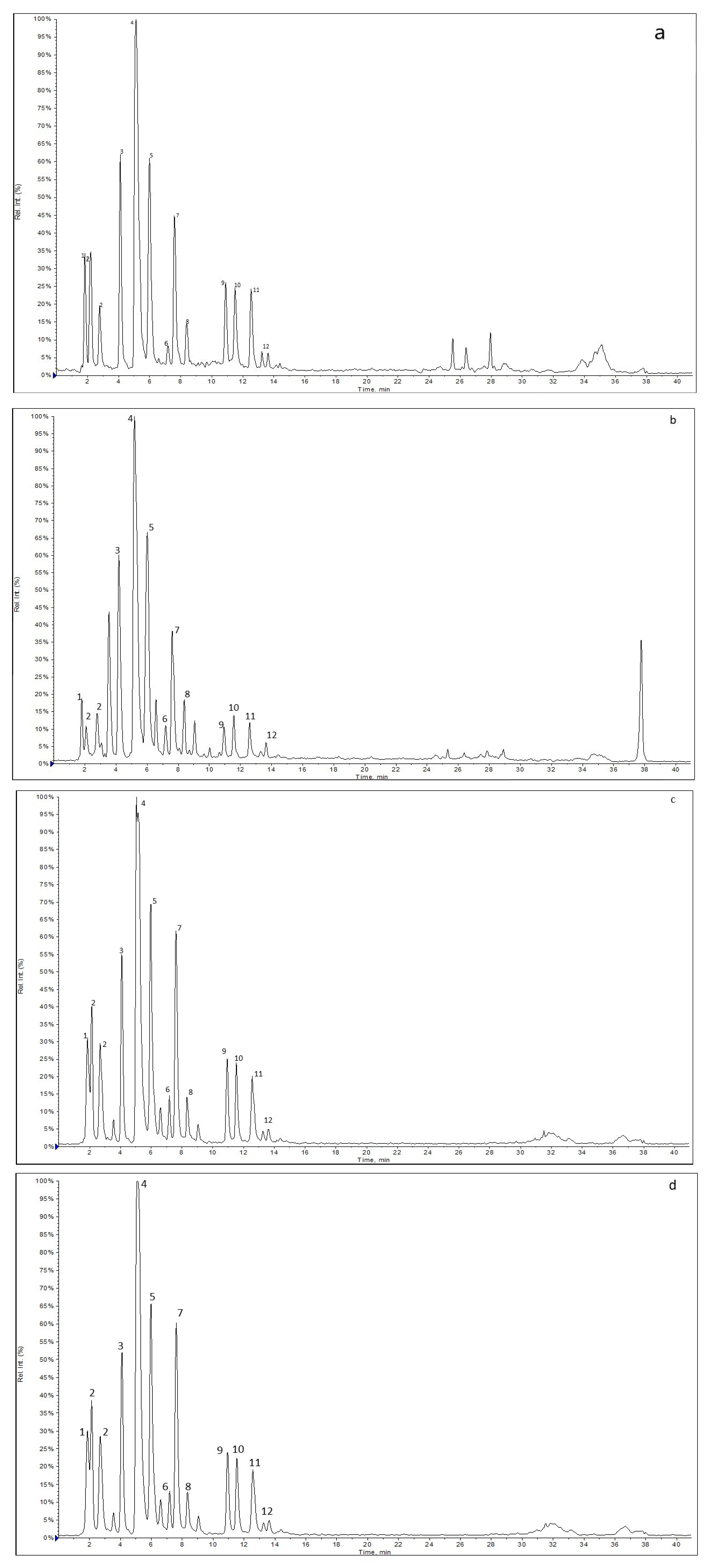
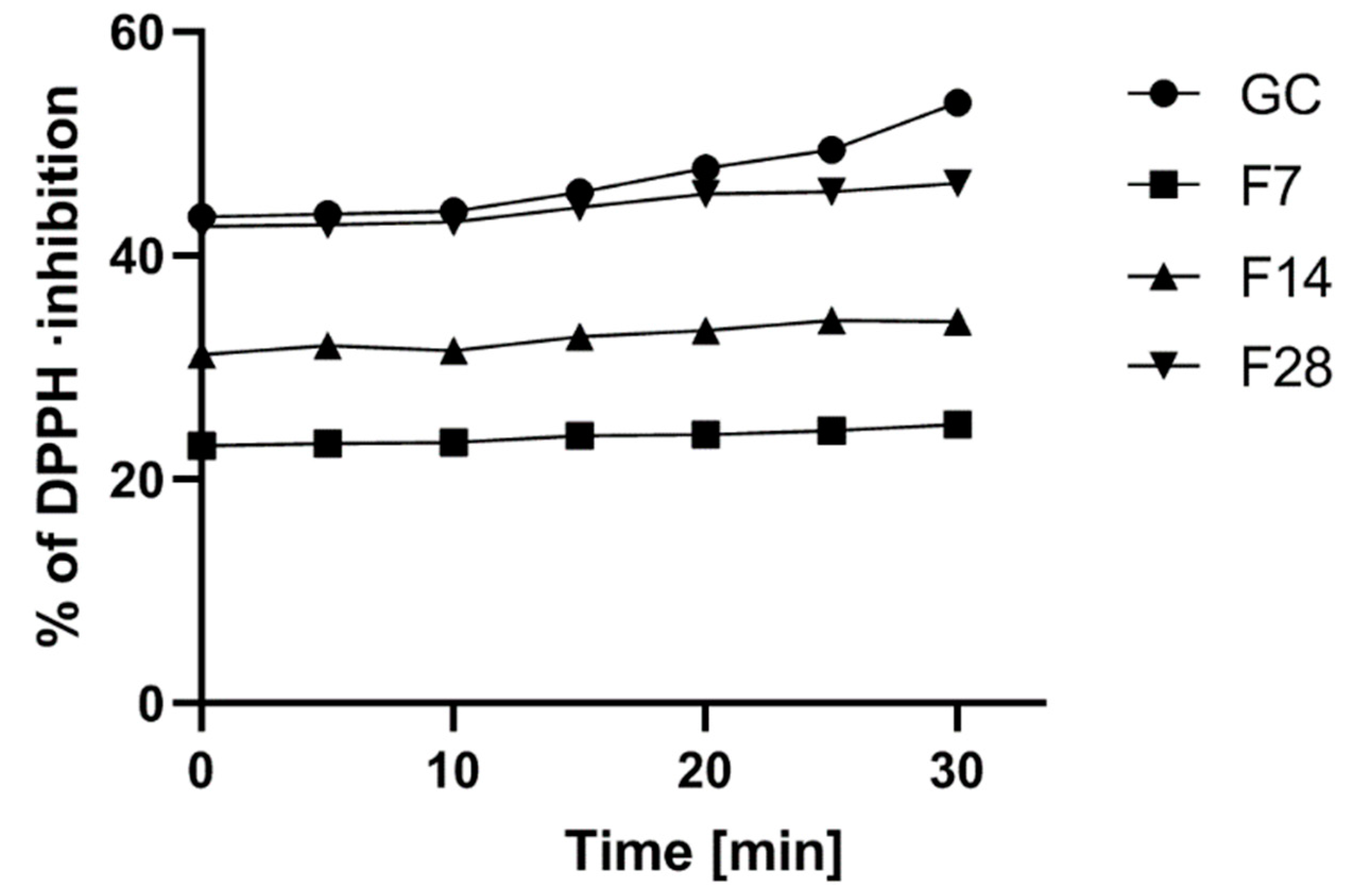

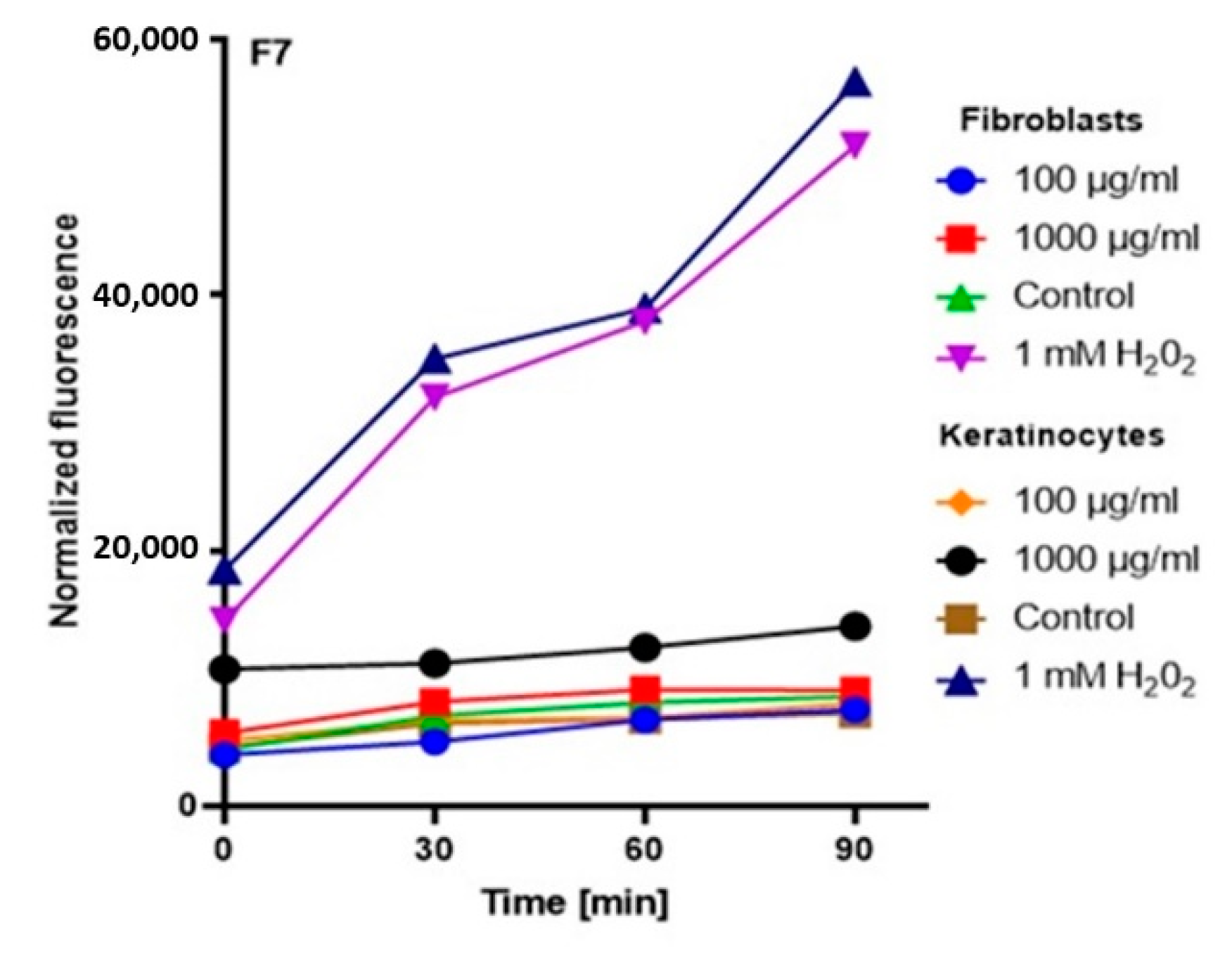
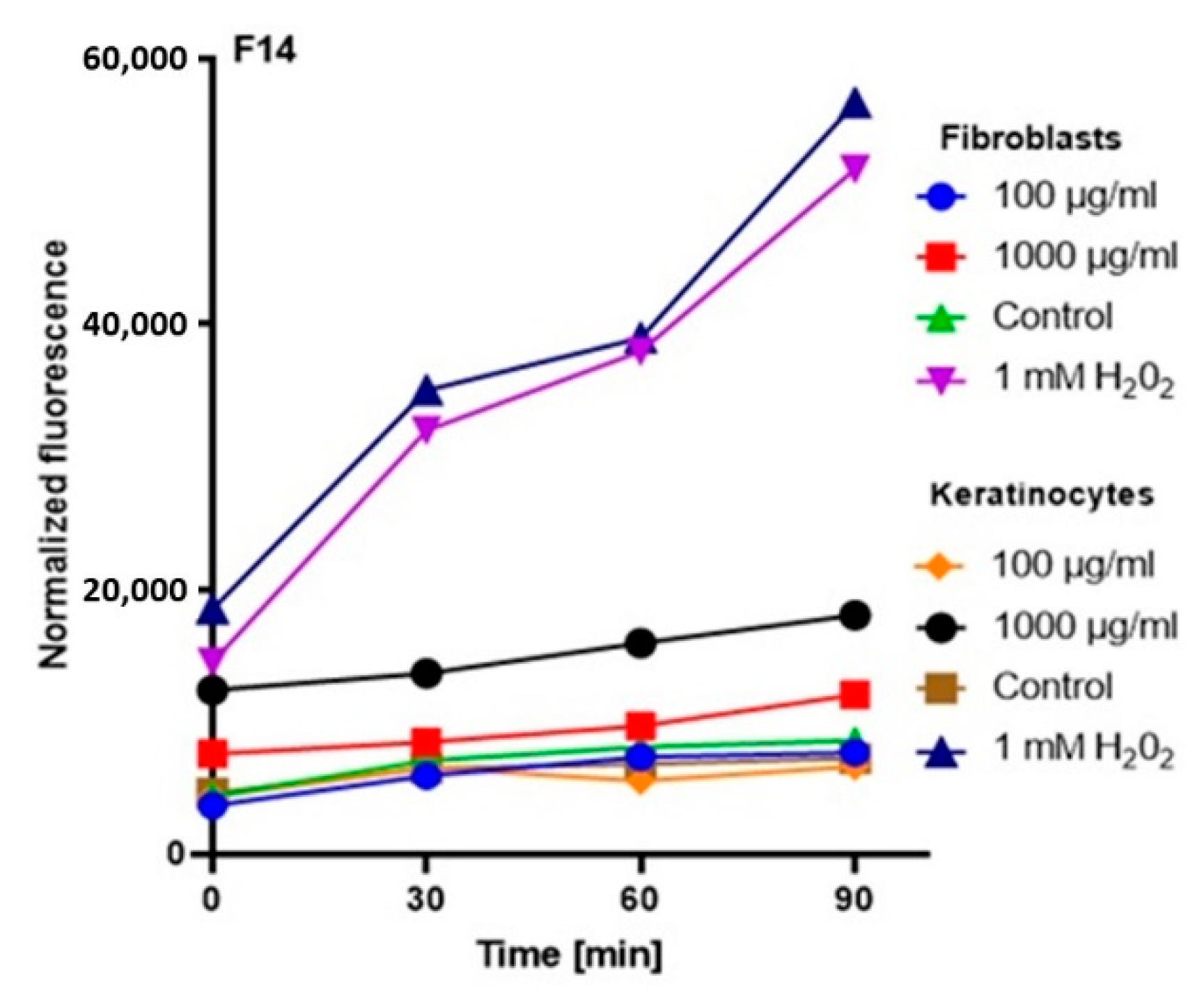
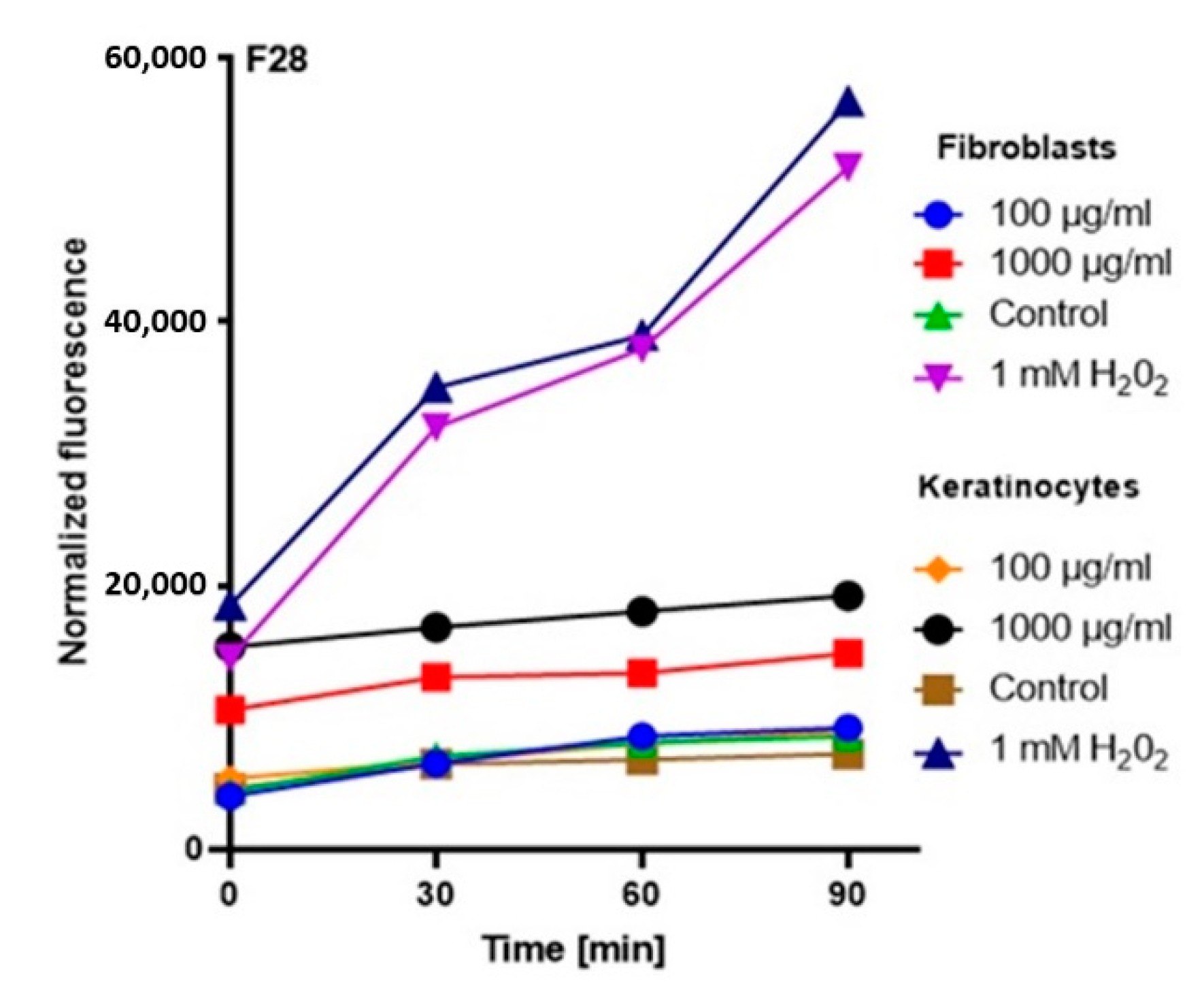

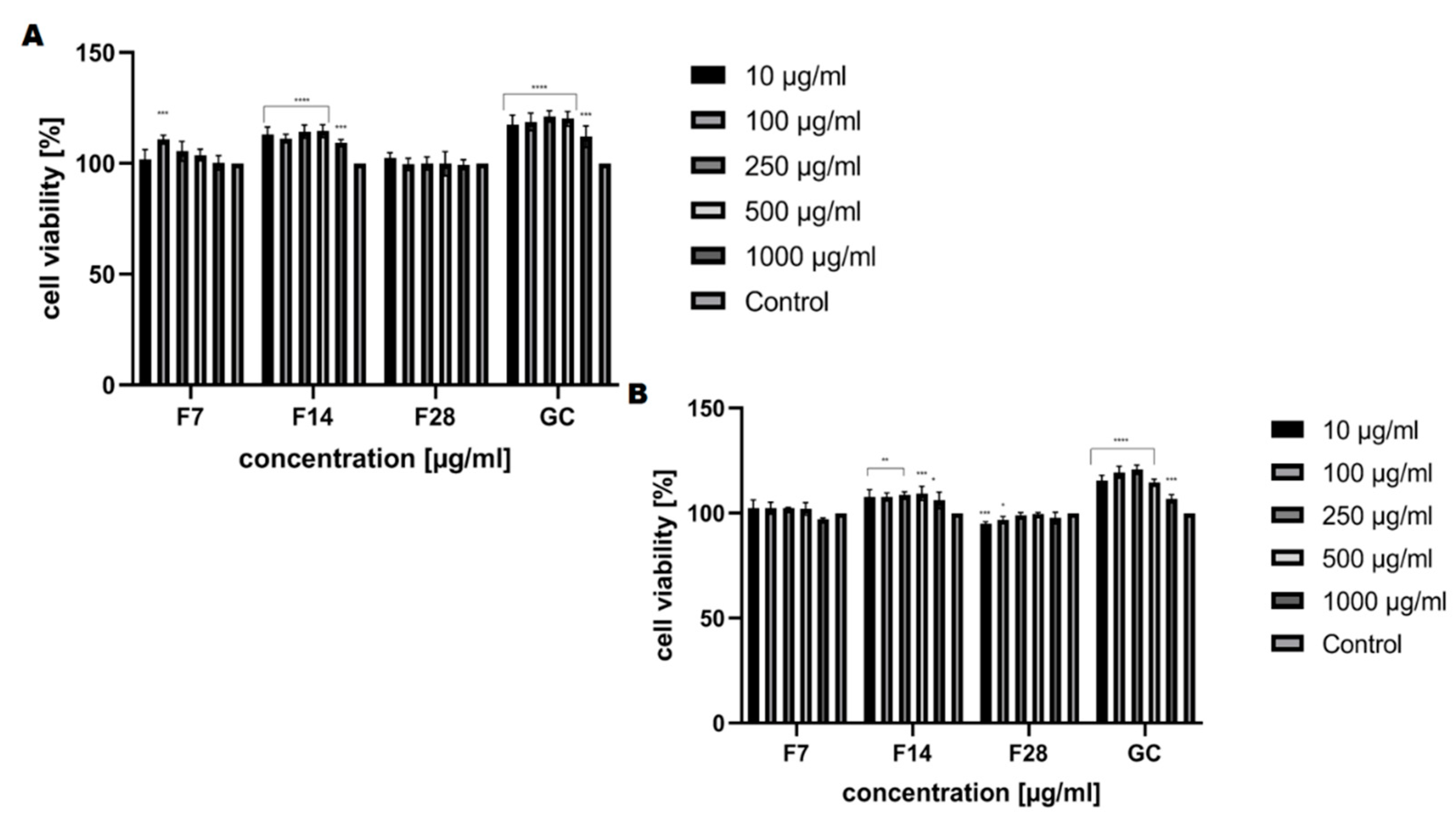
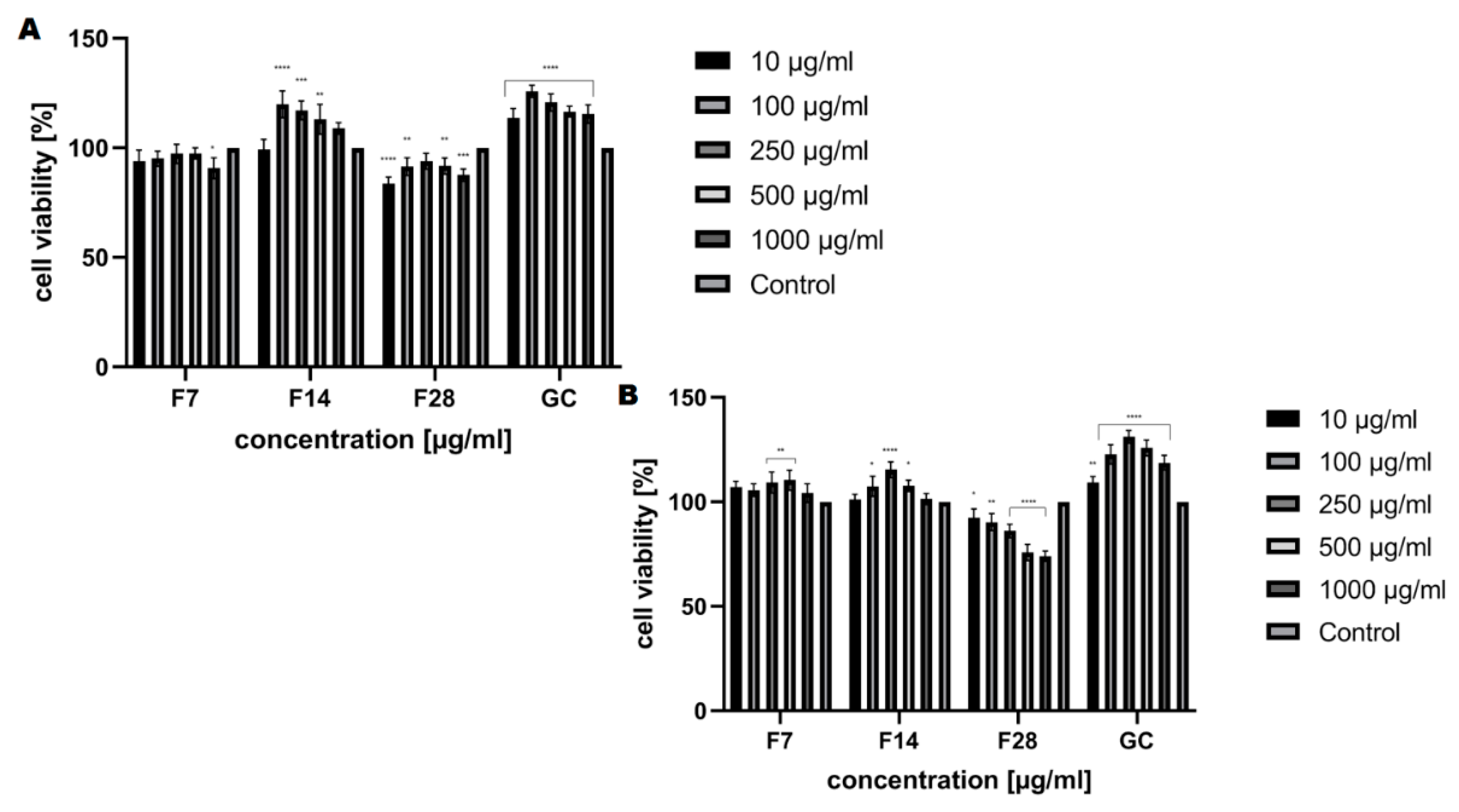
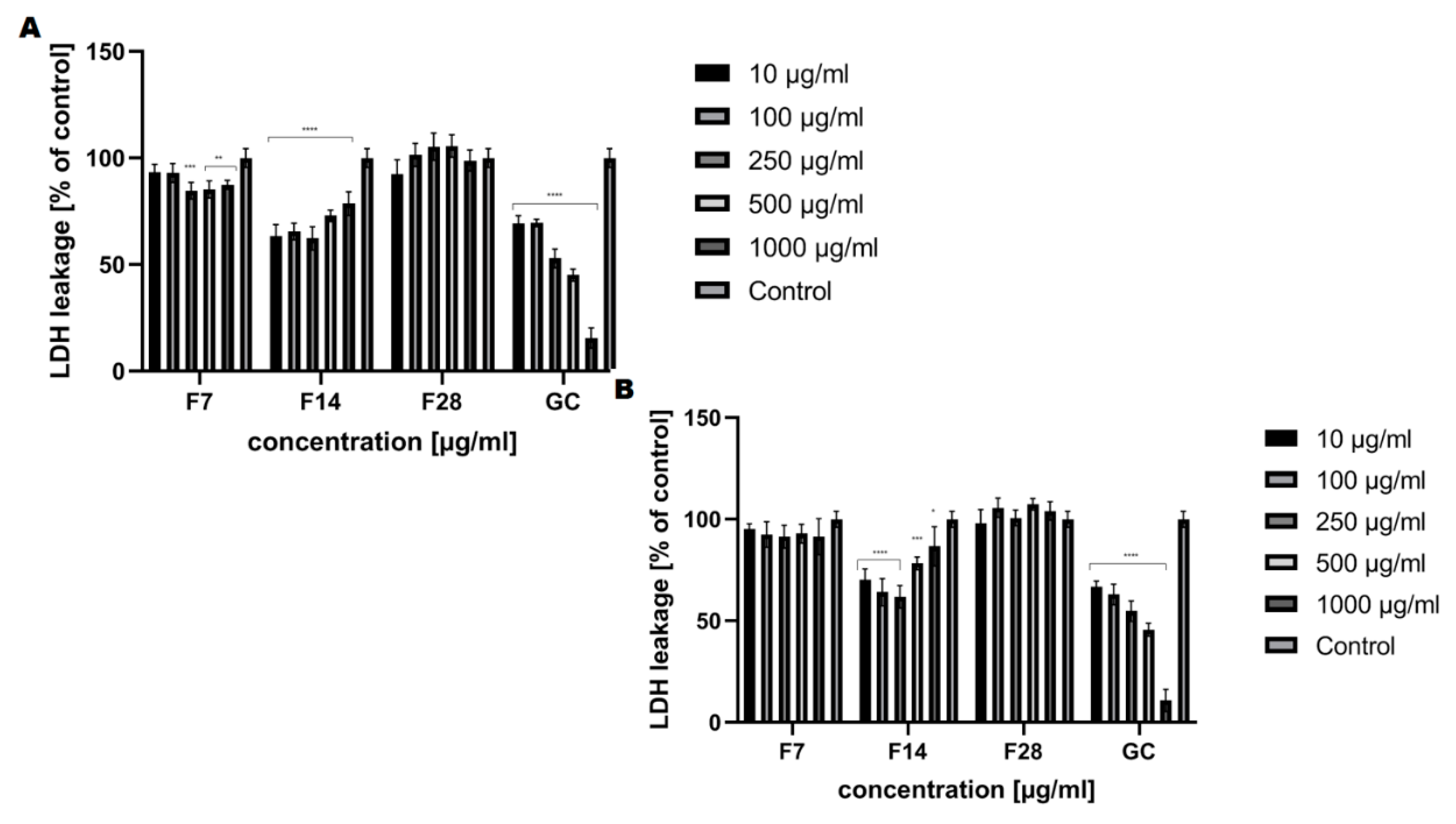
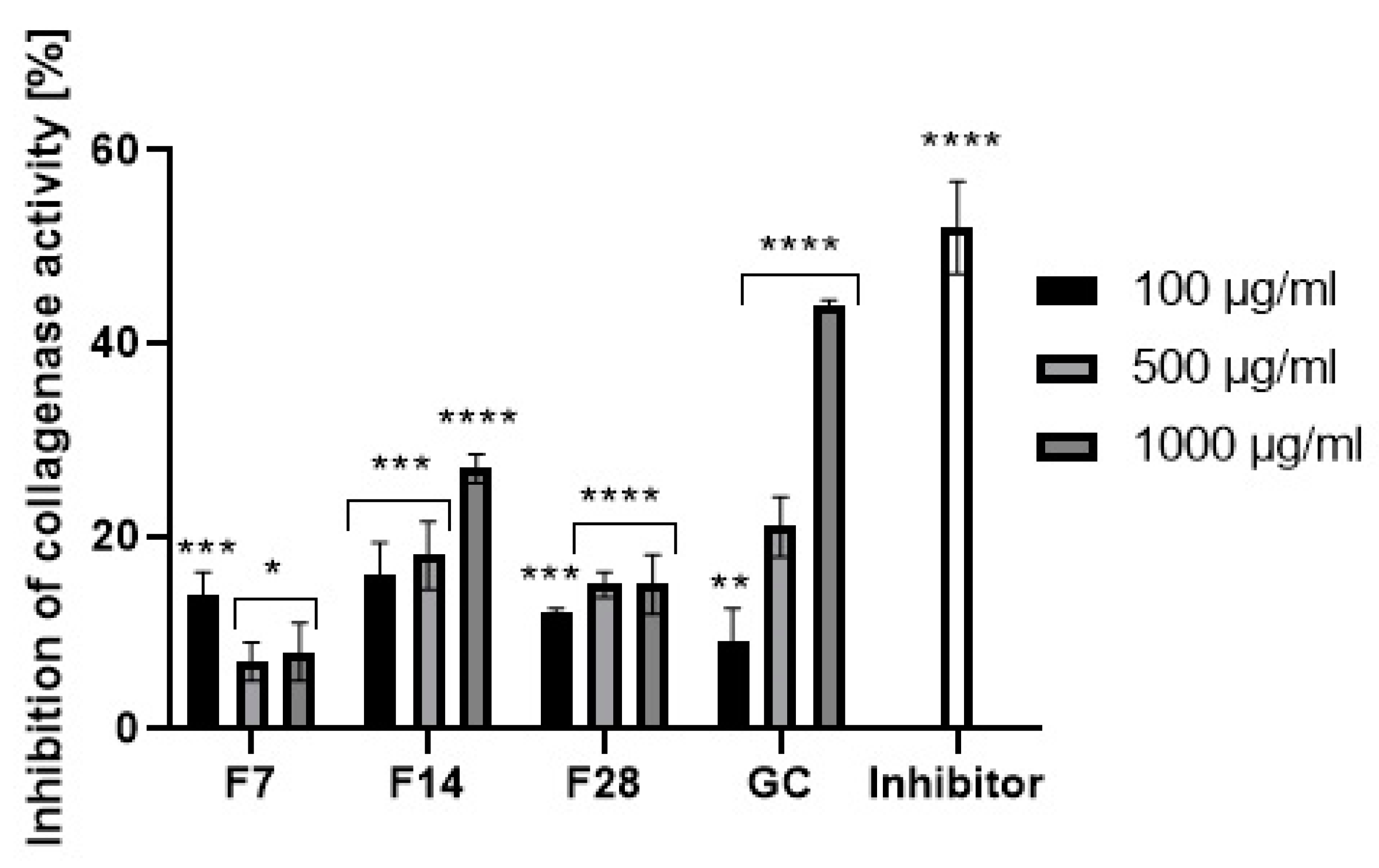
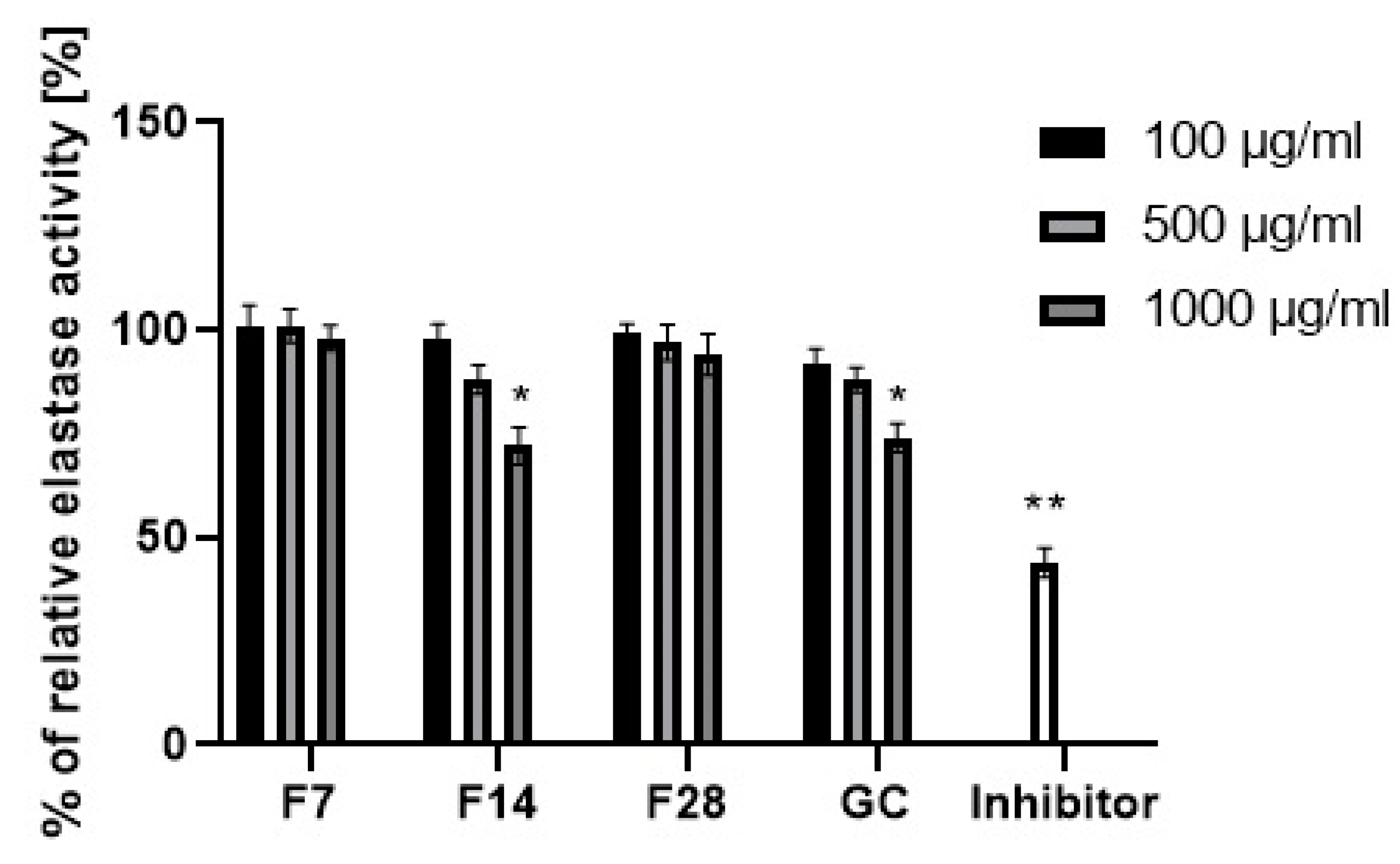


| TPC (mg GAE/g DW) | TFC (mg QE/g DW) | |
|---|---|---|
| GC | 630.05 ± 5.20 a | 156.84 ± 4.11 a |
| F7 | 106.76 ± 3.72 b | 17.02 ± 2.33 b |
| F14 | 243.14 ± 3.22 c | 51.10 ± 2.84 c |
| F28 | 392.56 ± 1.22 d | 66.53 ± 3.84 d |
| No. | Retention Time (min) | Molecular Formula | Molar Mass (Da) | Precursor Ion [M–H]− m/z | Main Productions MS2 m/z | Identification |
|---|---|---|---|---|---|---|
| Negative-Ion Mode | ||||||
| 1 | 1.8 | C9H8O4 | 180.2 | 179 [M–H]− | 135 [M-COOH]−, 107 [M-C3H5O2]−, 71 [M-C6H5O2]−, 59 [M-C7H5O2]− | Caffeic acid |
| 2 | 2.0/2.8 | C7H12O6 | 192.2 | 191 [M–H]− | 127 [M-H-H2O-HCOOH]−, 85 [M-C3H7O4]−, 59 [M-C5H9O4]− | Quinic acid |
| 3 | 4.1 | C16H18O9 | 354.3 | 353 [M–H]− | 191 [M-3H2O-C6H5O2]−, 179 [M-3H2O-C6H4-COOH]−,135 [M-3H2O-C6H4-C2HO4]− | 3-Caffeoylquinic acid |
| 4 | 5.2 | C16H18O9 | 354.3 | 353 [M–H]− | 191 [M-3H2O-C6H5O2]−, 179 [M-3H2O-C6H4-COOH]− | 5-Caffeoylquinic acid |
| 5 | 6.0 | C16H18O9 | 354.3 | 353 [M–H]− | 173 [M-C6H3-2OH-C2H2-COOH]−, 191 [M-3H2O-C6H5O2]−, 179 [M-3H2O-C6H4-COOH]−, 135 [M-3H2O-C6H4-C2HO4]− | 4-Caffeoylquinic acid |
| 6 | 7.2 | C16H18O8 | 338.3 | 337 [M–H]− | 191 [M-C9H7O11]−, 173 [M-C9H9O3]−, 163 [M-C7H11O5]− | 5-p-Coumaroylquinic acid |
| 7 | 7.6 | C17H20O9 | 368.3 | 367 [M–H]− | 191 [M-C10H9O3]−, 133 [M-C13H15O4]−, 173 [M-C10H11O4]− | 3-Feruloylquinic acid |
| 8 | 8.4 | C17H20O9 | 368.3 | 367 [M–H]− | 191 [M-C10H9O3]−, 173 [M-C10H11O4]− | 5-Feruloylquinic acid |
| 9 | 10.9 | C25H24O12 | 516.4 | 515 [M–H]− | 353 [M-C9H7O3]−, 335 [M-C9H9O4]−, 179 [M-C16H17O8]− | 3,4-Dicaffeoylquinic acid |
| 10 | 11.5 | C25H24O12 | 516.4 | 515 [M–H]− | 353 [M-C9H7O3]− | 3,5-Dicaffeoylquinic acid |
| 11 | 12.5 | C25H24O12 | 516.4 | 515 [M–H]− | 353 [M-C9H7O3]−, 179 [M-C16H17O8]− | 4,5-Dicaffeoylquinicacid |
| 12 | 13.2 | C26H26O12 | 530.5 | 529 [M–H]− | 353 [M-C10H9O3]−, 367 [M-C9H7O3]−, 191 [M-C16H19O8]− | 3-Caffeoyl,5-feruloylquinic acid |
| Positive-Ion Mode | ||||||
| 13 | 1.8 | C7H7NO2 | 137.1 | 138 [M + H]+ | 92 [M-H-H-CO2]+, 94 [M-CO2]+, 78 [M-H- H-CO2-CH3]+ | Trigonelline |
| 14 | 5.2 | C8H10N4O2 | 194.2 | 195 [M + H]+ | 138 [M-CO-N-CH3]+, 110 [M-CO-N-CH3-CO]+ | Caffeine |
| Compound | Content (mg/100g of Dry Weight of Green Coffee Beans) | |||
|---|---|---|---|---|
| GC | F7 | F14 | F28 | |
| 5-CQA | 4944.9 ± 229.9 | 2486.7 ± 32.3 | 3198.4 ± 15.3 | 2649.0 ± 34.7 |
| 4-CQA | 562.9 ± 14.7 | 483.7 ± 3.8 | 426.2 ± 6.9 | 531.1 ± 5.5 |
| 3-CQA | 397.9 ± 13.0 | 390.7 ± 13.0 | 275.5 ± 0.3 | 429.1 ± 1.8 |
| 3.5-diCQA | 61.2 ± 0.7 | 49.9 ± 4.5 | <LOD | 71.2 ± 2.5 |
| 4.5-diCQA | 101.2 ± 2.0 | 41.5 ± 3.6 | <LOD | 61.5 ± 2.3 |
| 3.4-diCQA | 44.0 ± 0.6 | 33.7 ± 2.2 | <LOD | 50.1 ± 1.9 |
| 3-FQA | 20.7 ± 0.5 | 17.7 ± 2.7 | 9.2 ± 2.4 | 19.0 ± 0.3 |
| 4-FQA | <LOD | <LOD | <LOD | <LOD |
| 5-FQA | 544.1 ± 1.3 | 345.8 ± 5.9 | 319.3 ± 4.6 | 350.4 ± 2.7 |
| Sum of quantified phenolic compounds | 6677.0 | 3849.7 | 4228.6 | 4161.3 |
| Caffeine | 1956.1 ± 29.0 | 1403.4 ± 1.2 | 1165.3 ± 4.1 | 1349.4 ± 1.0 |
| Trigonelline | 1205.5 ± 22.1 | 922.3 ± 1.2 | 910.4 ± 1.4 | 839.8 ± 1.0 |
| Sum of quantified compounds | 9838.6 | 6175.5 | 6304.4 | 6350.6 |
| Sample | GC | F7 | F14 | F28 |
|---|---|---|---|---|
| SPF | 3.15 ± 0.22 | 0.73 ± 0.09 | 2.14 ± 0.12 | 2.57 ± 0.13 |
| Compound | Molar Extinction Coefficient (×104) (M−1 cm−1) | λmax (nm) |
|---|---|---|
| 5-CQA | 1.95 | 330 |
| 4-CQA | 1.80 | |
| 3-CQA | 1.84 | |
| 3,4-diCQA | 3.18 | |
| 3,5-diCQA | 3.16 | |
| 4,5-diCQA | 3.32 | |
| 5-FQA | 1.93 | 325 |
| 4-FQA | 1.95 | |
| 3-FQA | 1.90 |
Publisher’s Note: MDPI stays neutral with regard to jurisdictional claims in published maps and institutional affiliations. |
© 2020 by the authors. Licensee MDPI, Basel, Switzerland. This article is an open access article distributed under the terms and conditions of the Creative Commons Attribution (CC BY) license (http://creativecommons.org/licenses/by/4.0/).
Share and Cite
Zofia, N.-Ł.; Aleksandra, Z.; Tomasz, B.; Martyna, Z.-D.; Magdalena, Z.; Zofia, H.-B.; Tomasz, W. Effect of Fermentation Time on Antioxidant and Anti-Ageing Properties of Green Coffee Kombucha Ferments. Molecules 2020, 25, 5394. https://doi.org/10.3390/molecules25225394
Zofia N-Ł, Aleksandra Z, Tomasz B, Martyna Z-D, Magdalena Z, Zofia H-B, Tomasz W. Effect of Fermentation Time on Antioxidant and Anti-Ageing Properties of Green Coffee Kombucha Ferments. Molecules. 2020; 25(22):5394. https://doi.org/10.3390/molecules25225394
Chicago/Turabian StyleZofia, Nizioł-Łukaszewska, Ziemlewska Aleksandra, Bujak Tomasz, Zagórska-Dziok Martyna, Zarębska Magdalena, Hordyjewicz-Baran Zofia, and Wasilewski Tomasz. 2020. "Effect of Fermentation Time on Antioxidant and Anti-Ageing Properties of Green Coffee Kombucha Ferments" Molecules 25, no. 22: 5394. https://doi.org/10.3390/molecules25225394
APA StyleZofia, N.-Ł., Aleksandra, Z., Tomasz, B., Martyna, Z.-D., Magdalena, Z., Zofia, H.-B., & Tomasz, W. (2020). Effect of Fermentation Time on Antioxidant and Anti-Ageing Properties of Green Coffee Kombucha Ferments. Molecules, 25(22), 5394. https://doi.org/10.3390/molecules25225394






